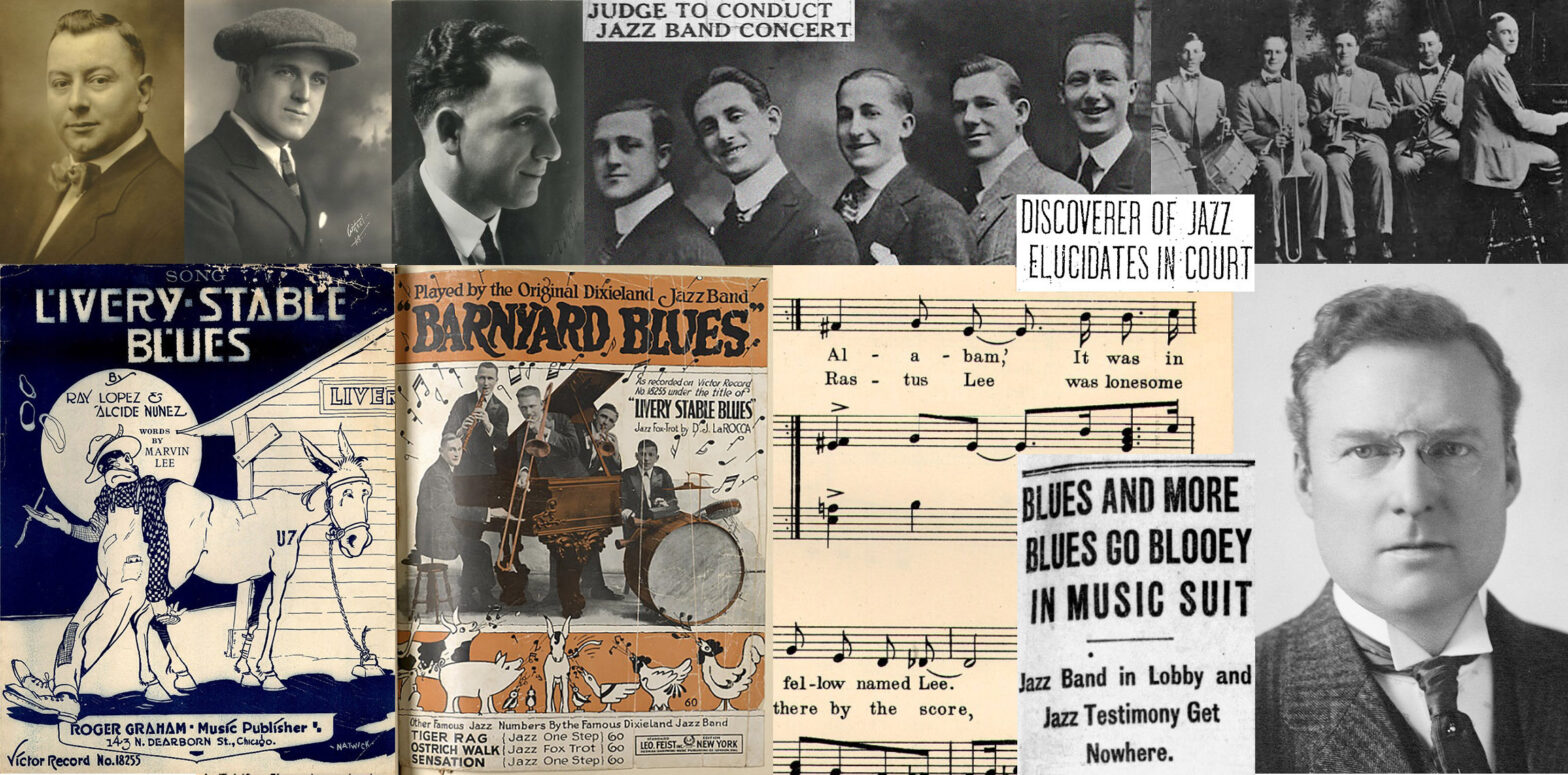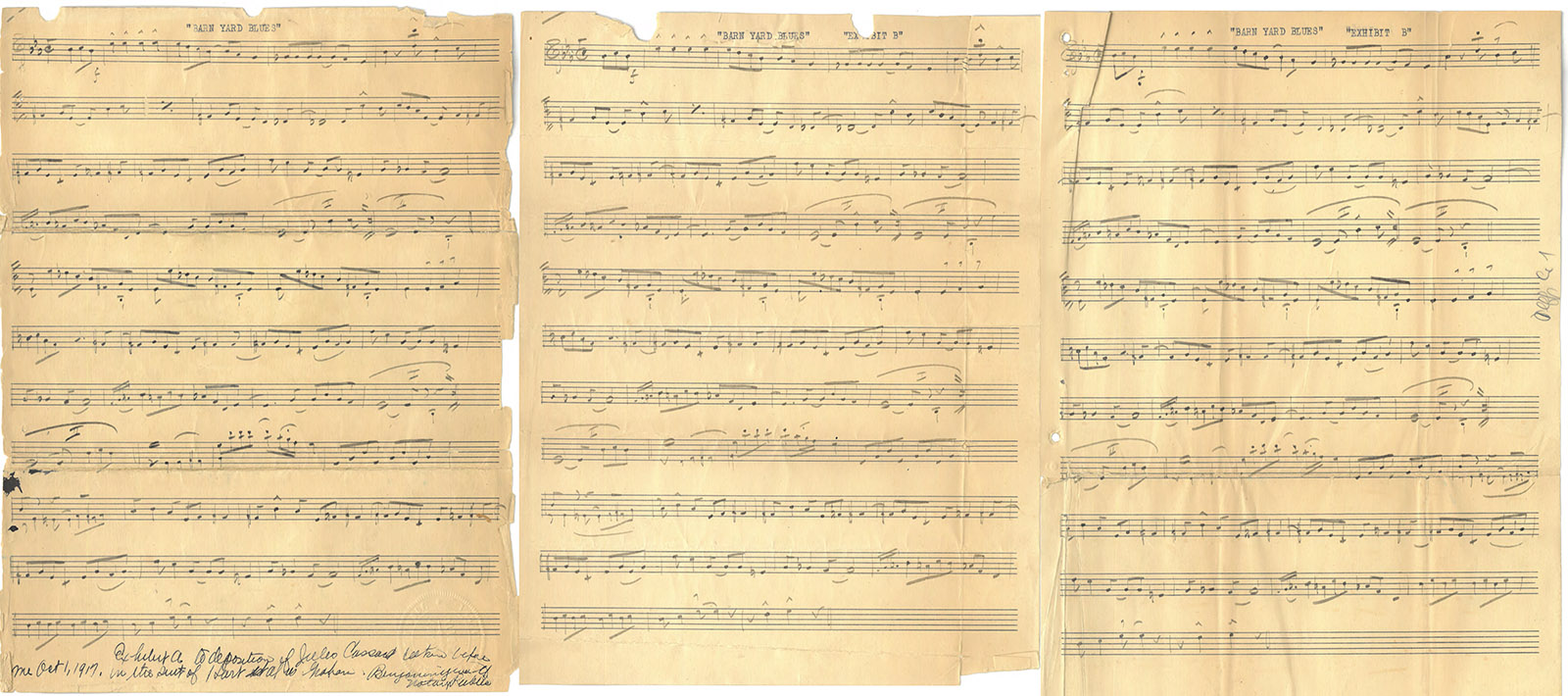Chapter 17 of
The Coolest Spot in Chicago:
A History of Green Mill Gardens and the Beginnings of Uptown
<— PREVIOUS CHAPTER / TABLE OF CONTENTS / NEXT CHAPTER —>
In the midst of Chicago’s jazz boom and cabaret controversies of 1917, the city played host to a curious event in the annals of legal and musical history: a court case involving what may be the very first jazz record.
On March 7, 1917, the Victor Talking Machine Company released a recording by the Original Dixieland Jass Band, a group of musicians from New Orleans who’d first come together to play in Chicago in 1916. The record’s A-side was “Dixieland Jass Band One-Step,” and “Livery Stable Blues” was on the B-side. It quickly set a new sales record for the company.1
Here’s what an advertisement in the New Orleans Item said about the record:
“A brass band gone crazy!” That’s the way a wag describes the original Dixieland “Jass” Band. Beyond that description we can’t tell you what a “Jass” Band is because we don’t know ourselves. As for what it does—it makes dancers want to dance more—and more—and yet more! Just have another look at the picture above—you can almost hear the hilarious music of the “Jass” Band in your ears.2
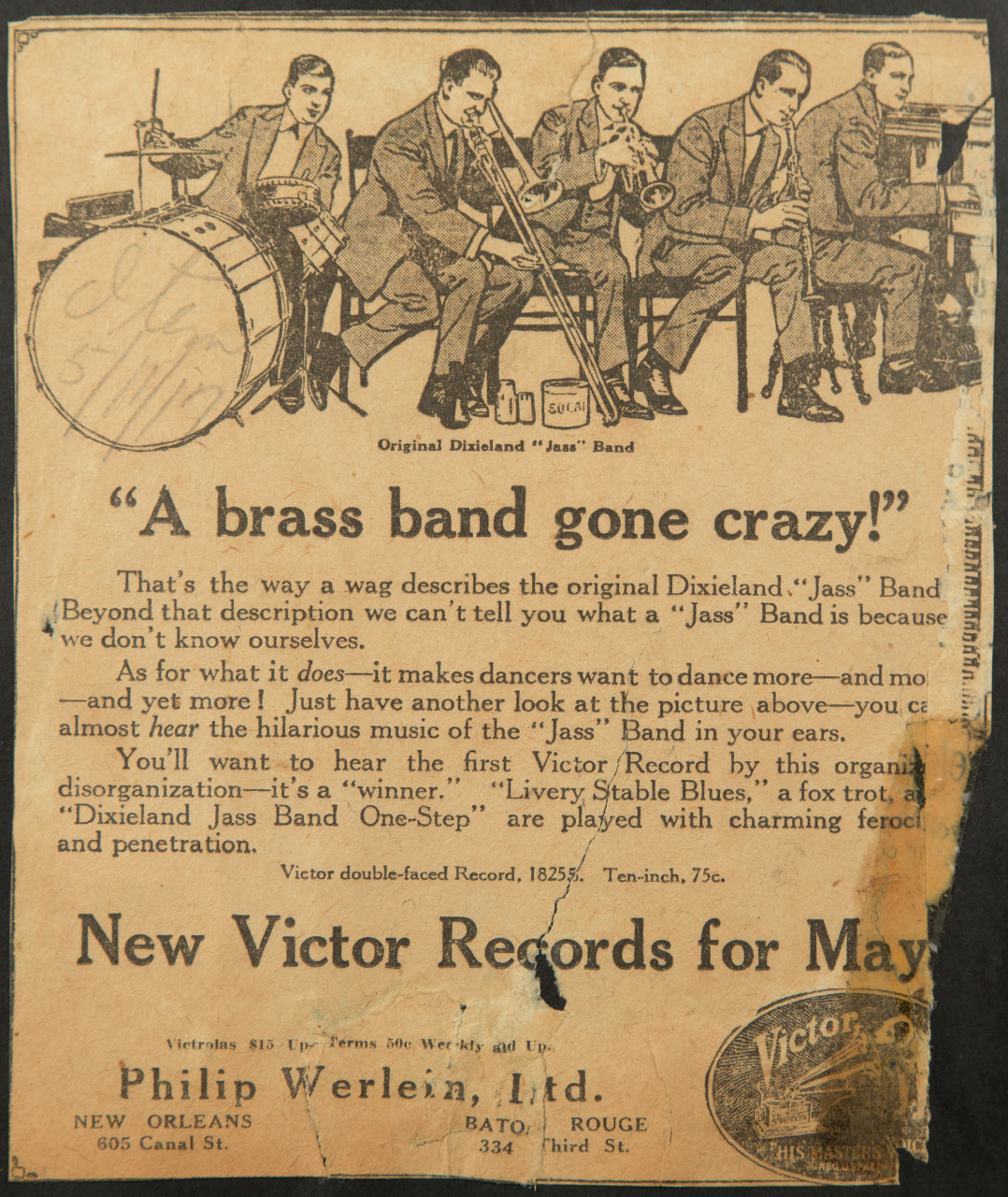
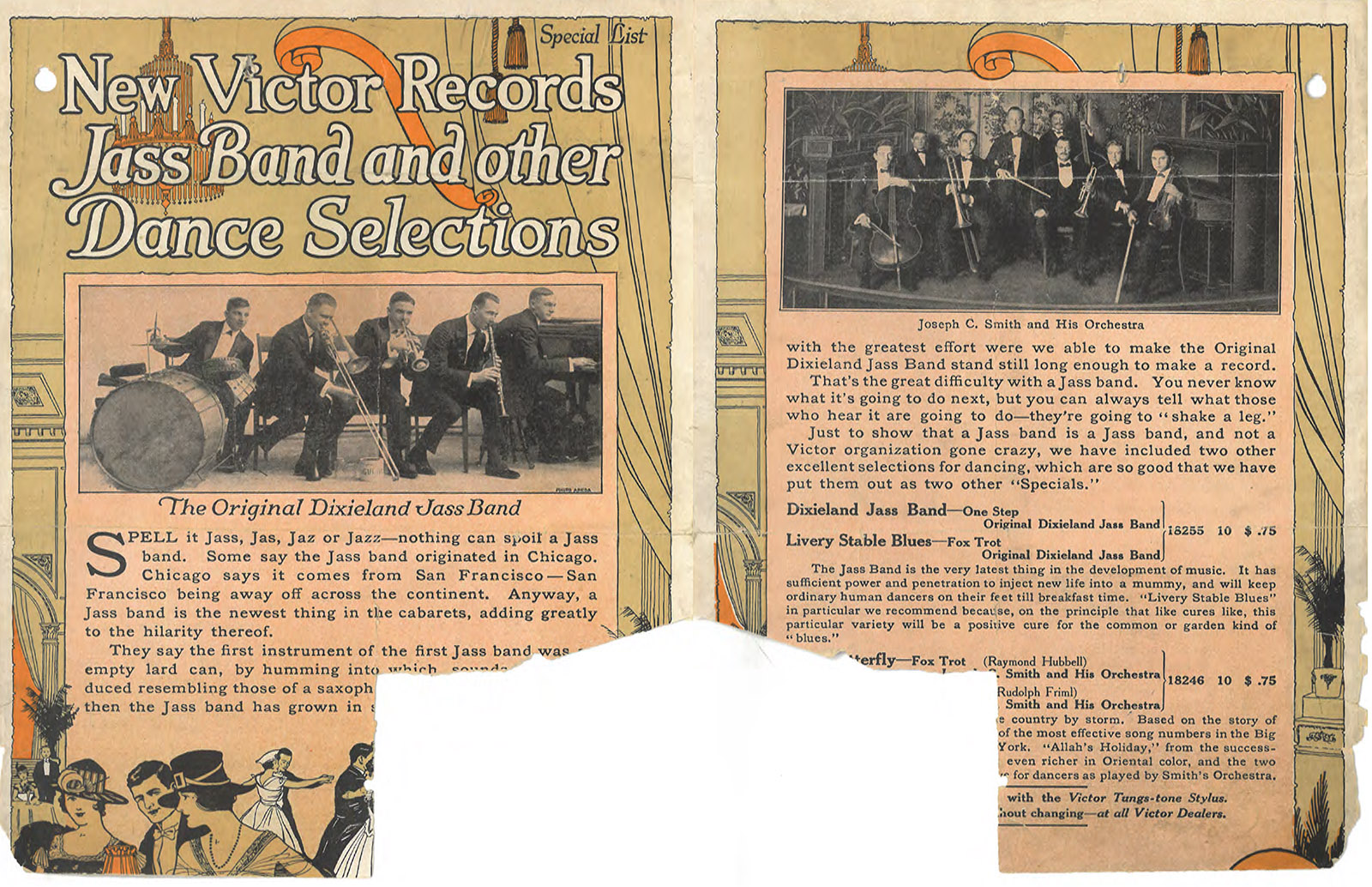
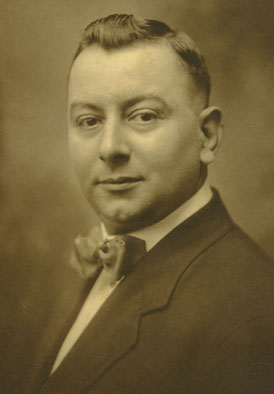
Clarinetist Alcide “Yellow” Nuñez had a different reaction when he heard the record in Chicago in May 1917.
Nuñez, a former member of the Original Dixieland Jass Band, recognized “Livery Stable Blues” as a song he’d helped to create when he was still in the group a year earlier.
The 33-year-old Nuñez—whose parents were Isleño (as immigrants from the Canary Islands are known) and French Creole—said he’d contributed to the portion of the song featuring horns imitating barnyard animals.
In addition, he alleged that the bulk of the tune was copied from “More Power Blues,” a song his friend Ray Lopez had written years earlier for a group in New Orleans called Brown’s Band, who’d come to play in Chicago in 1915 (as chronicled in Chapter 12).
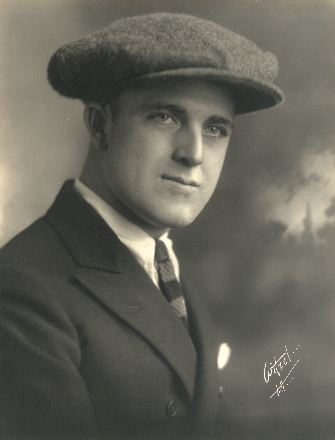
Nuñez and Lopez weren’t making any money from this record, so they decided to publish sheet music of the song. Neither could read or write music, but they got together with piano player Guy Shrigley at the Sherman Hotel’s College Inn in Chicago and he wrote out the song.3
They took it to Chicago music publisher Roger Graham. (You may remember Graham from Chapter 11—he was lyricist from Rhode Island who told the legend about how jazz supposedly got its name from a performer named Jasbo Brown.)
“I’m entitled to the authorship of ‘The Livery Stable Blues’—me and Lopez, as much as LaRocca,” Nuñez said, referring to cornetist Dominick “Nick” LaRocca, the Original Dixieland Jass Band’s leader. “That’s why I went to Roger Graham and had him publish it. LaRocca done me dirt, so I says to myself, ‘He’s done me dirt and I’ll let him out.’ He goes and has our ‘Livery Stable Blues’ put on a phonograph record as his’n. Well, ain’t that dirt?”4
There was no singing on the record of “Livery Stable Blues,” and Graham published sheet music by Lopez and Nuñez without any words in June 1917—a copy of which survives in federal court records.
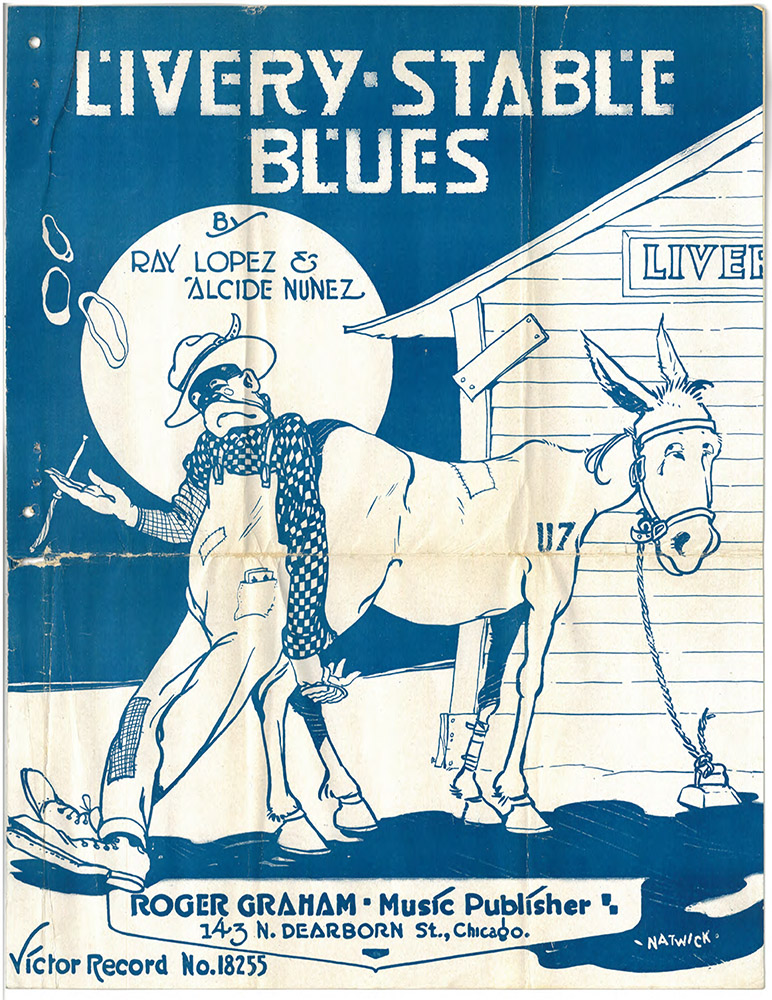
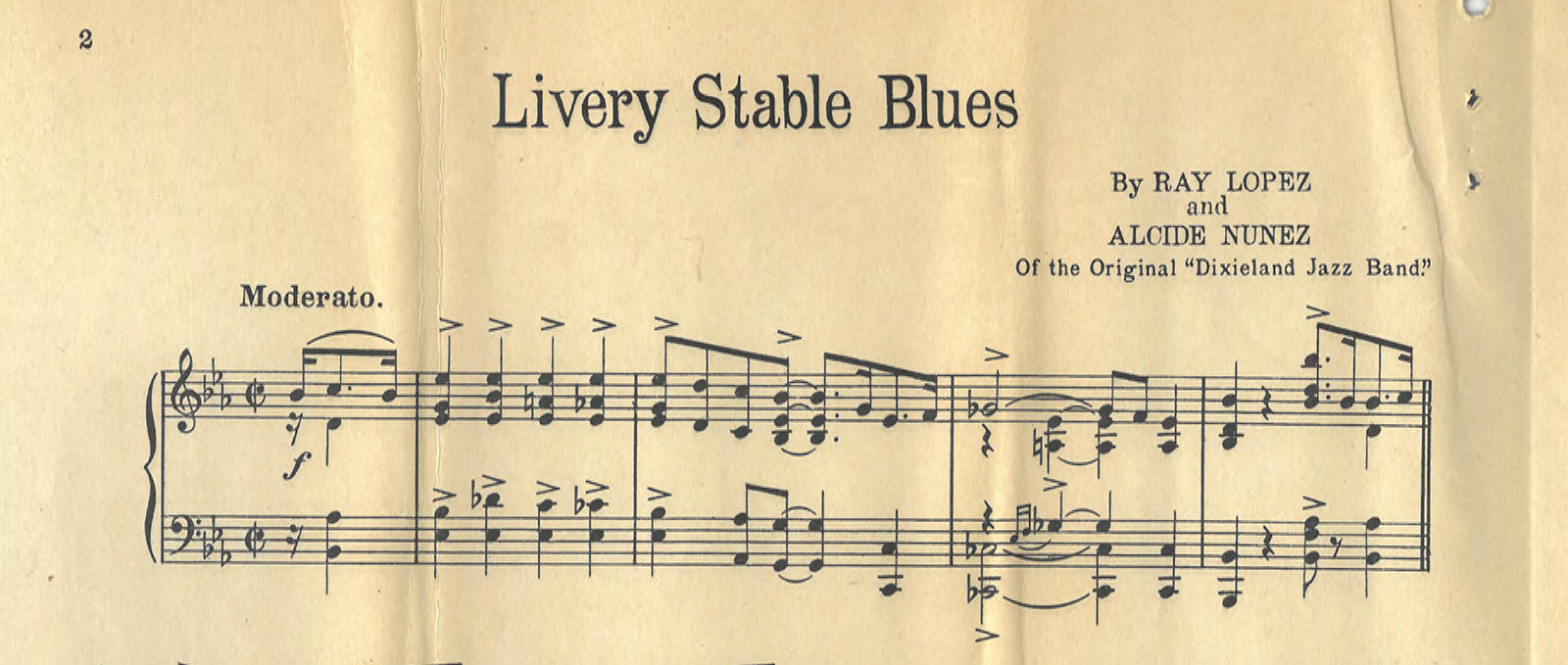
However, Graham also published a version featuring words by Chicago lyricist Marvin Lee—about “a lazy colored fellow named Lee” in Birmingham, Alabama. (The second verse calls him “Old Ephram Rastus Lee.”) Instead of working, this character plays a tune on a stable brush and sings “this sad and lonesome melody” to the horses in a livery barn. “I wasn’t born for this,” he explains, when he sings about “those mean old Liv’ry Stable Blues.” Later, he adds: “It ain’t no fun of course, to sleep here with a horse.”5
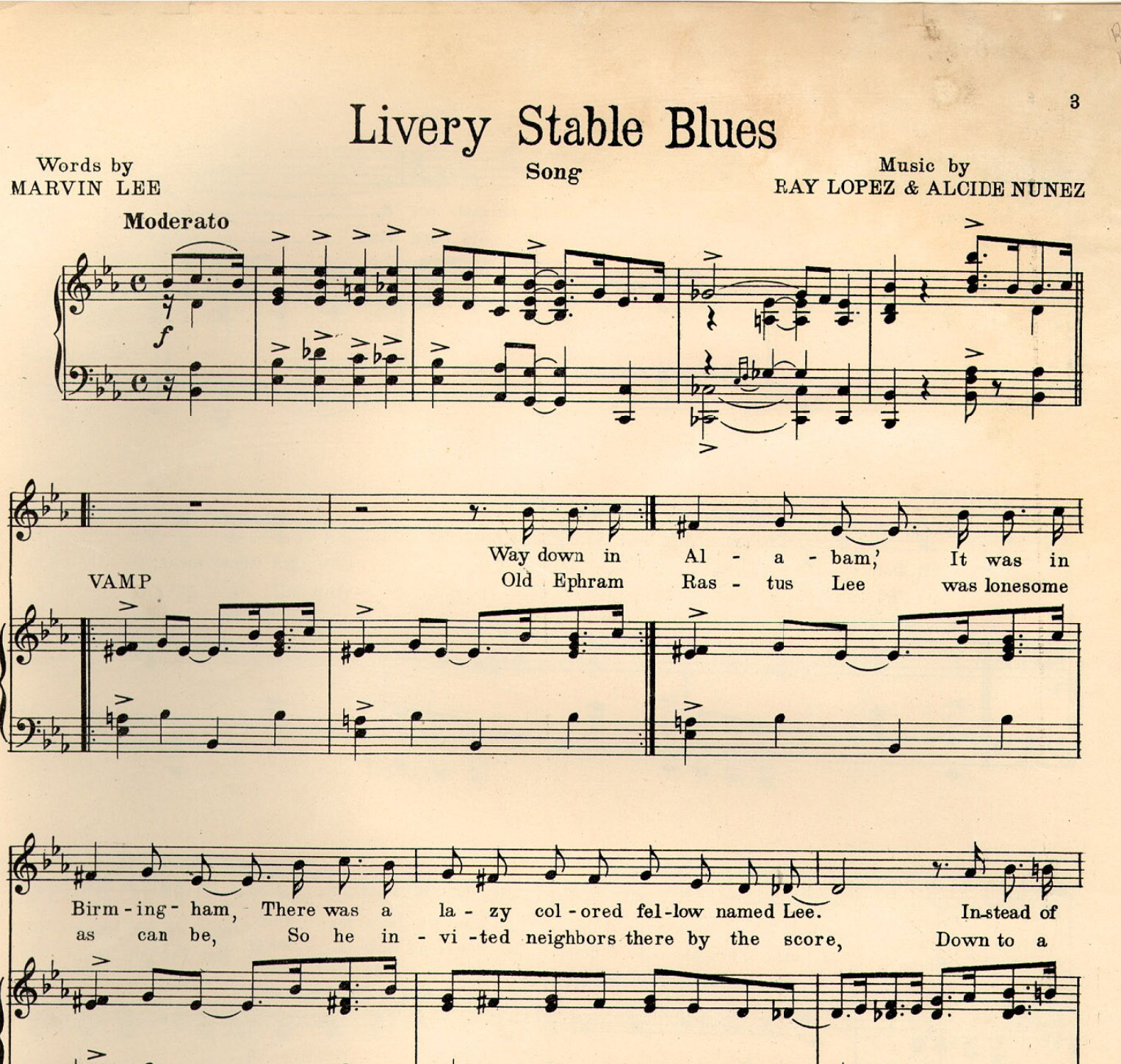
New York music publisher Leo Feist soon released the Original Dixieland Jazz Band’s own sheet music for the song, under the title “Barnyard Blues,” with LaRocca credited as the composer. (By this time, the band had changed the spelling of the word Jass in its name to Jazz.)
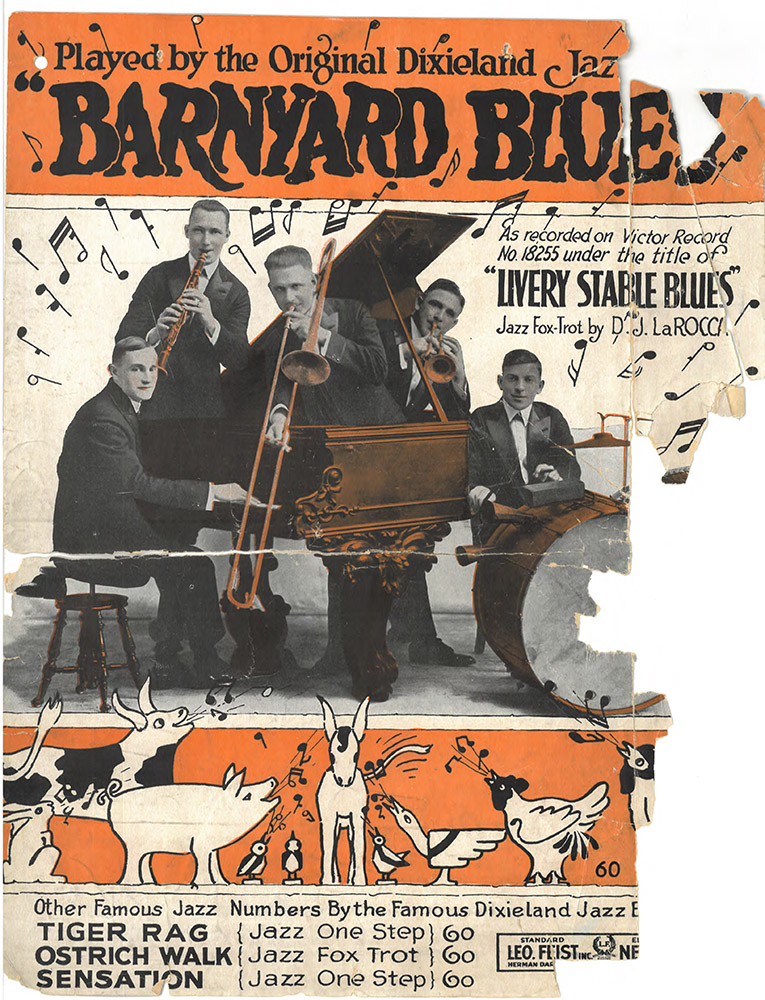
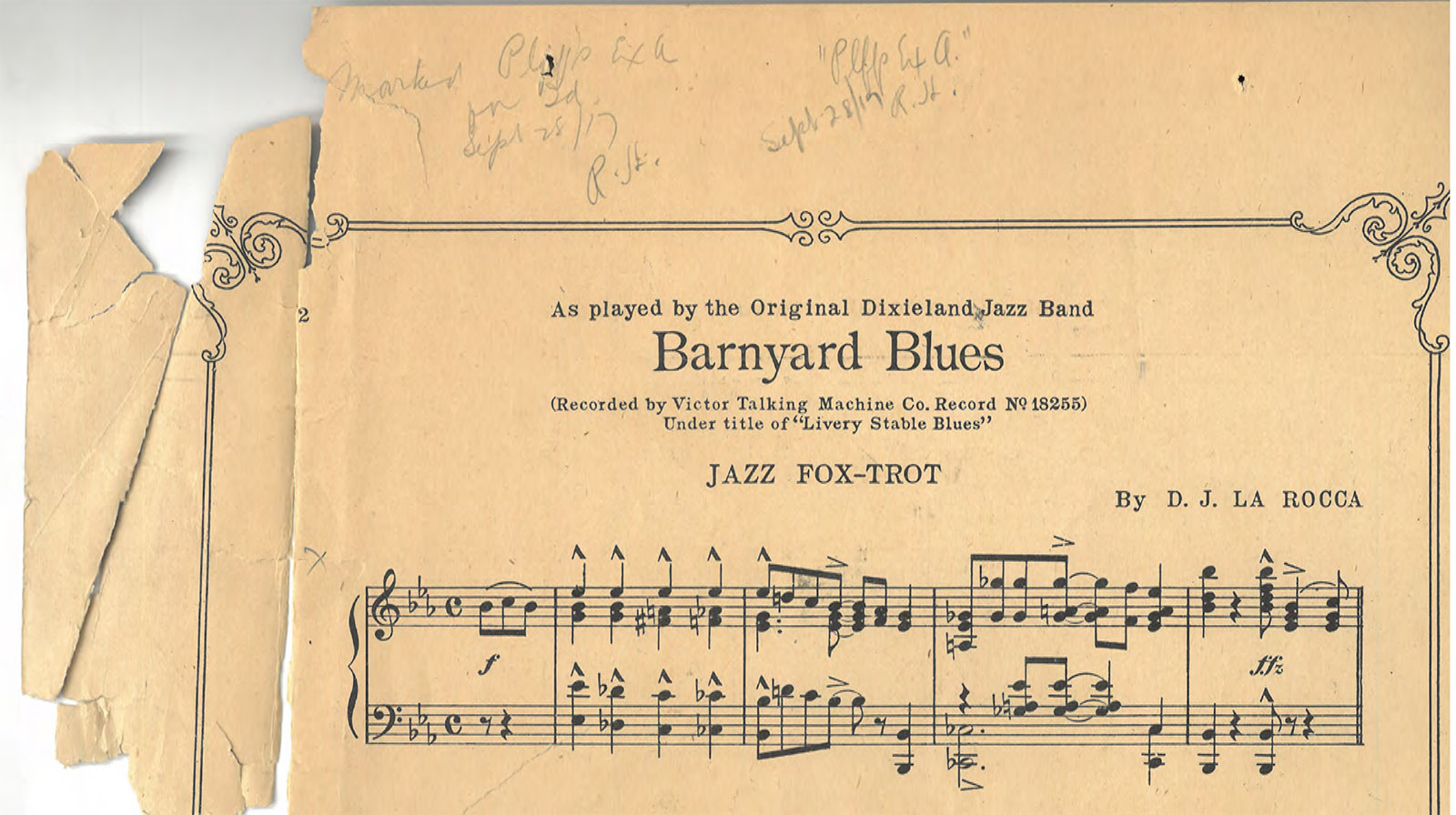
This version of the song included notations about where to make the music sound like animals.
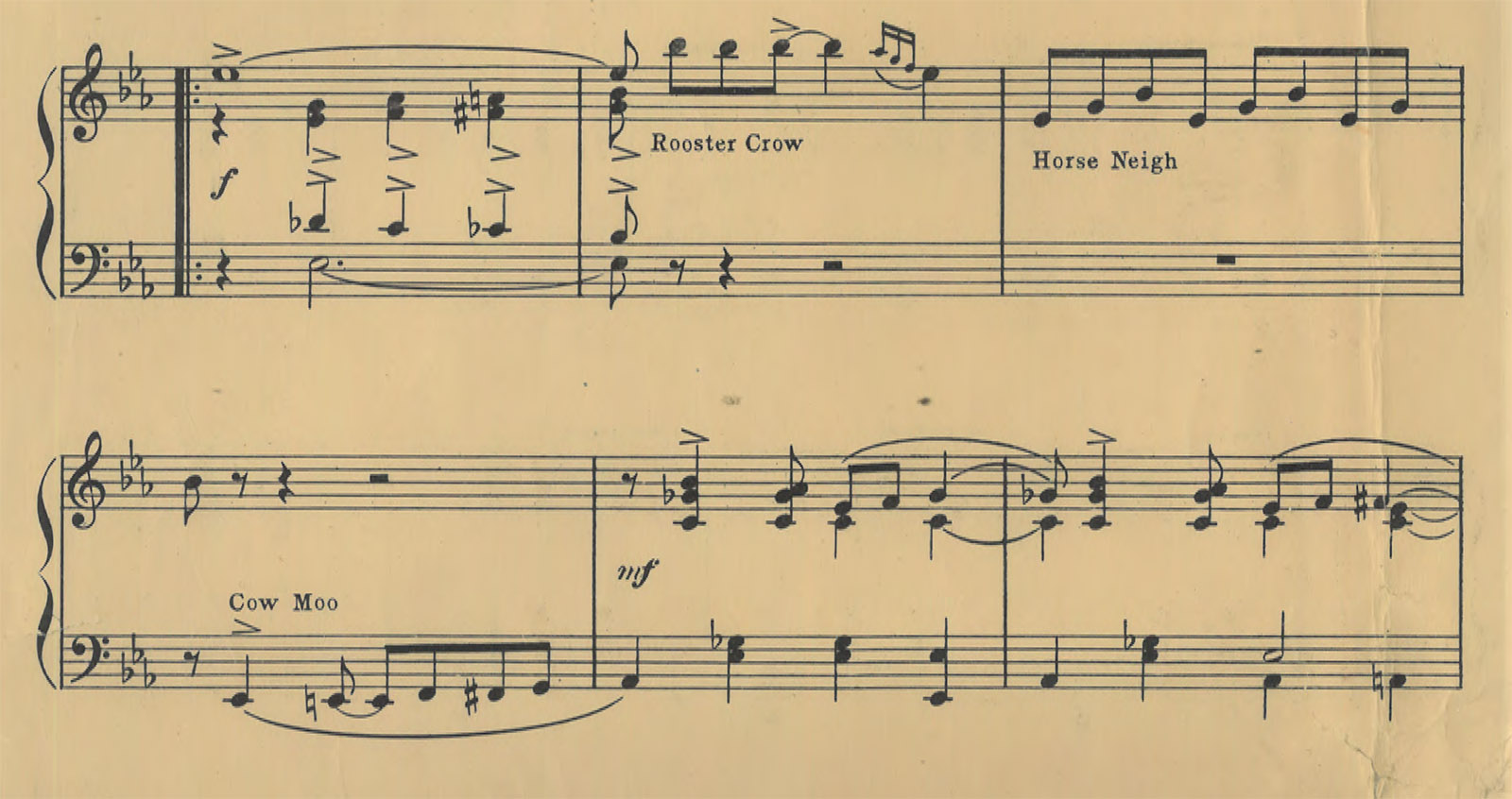
Remarkably, both songs on that 1917 record sparked litigation. The Original Dixieland Jass Band was accused of including a strain of Chicago bandleader Joe Jordan’s 1909 song “That Teasin’ Rag” in the record’s A-side, “Dixieland Jass Band One-Step.” That lawsuit was settled out of court, with an agreement changing the title on future pressings of the record label: It was now called “Dixie Jass Band One-Step Introducing That Teasin’ Rag.”6
Meanwhile, the litigation over “Livery Stable Blues” resulted in a trial in October 1917. The rival musicians and publishers squared off in U.S. District Court in downtown Chicago, trying to resolve the question: Who wrote this song?7
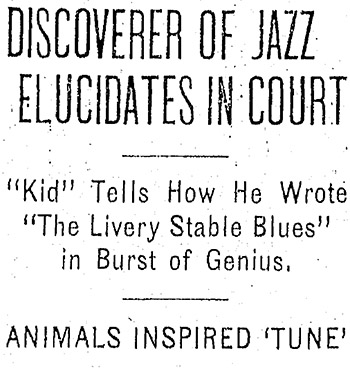
Judge George Albert Carpenter presided over a 10-day trial.8 Jazz was a hot topic at the time—a popular new style of music with a peculiar name—and so it’s not surprising that newspapers were interested in this court case about the first jazz record.9
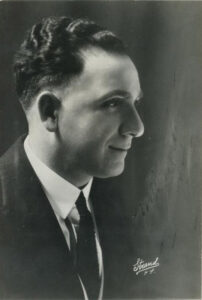
Reading some of these articles, people might have thought that the judge was trying to determine who invented jazz. “Discoverer of Jazz Elucidates in Court,” a Chicago Daily News headline said. This supposed “discoverer” was LaRocca, 28, a flashy character whose parents were poor Sicilian immigrants in New Orleans.10 The Daily News called him “the Jazz Kid” and “the giddy boy whose brain first got the big idea.” Summarizing La Rocca’s testimony, the newspaper reported: “He identified himself as the genuine Columbus of the Jazz, the Sir Isaac Newton of the latest dance craze.”
LaRocca was actually just telling his version of how “Livery Stable Blues” was written, not how he’d invented jazz. 11 LaRocca told a colorful story (as recounted in Chapter 15) about making his cornet sound like a horse when the band was playing at the Schiller Café on Chicago’s South Side in 1916: “Well, a valve in my cornet got stuck and it made a funny noise. I experimented with the bray or neigh, and finally worked out my ‘Livery Stable’ melody. One day when our band had finished playing a number at the Schiller Café, here in Chicago, there was a girl sort of skylarking around the floor, and I blew a horse neigh at her on my cornet. She laughed. … And then I taught my composition to the band.”12
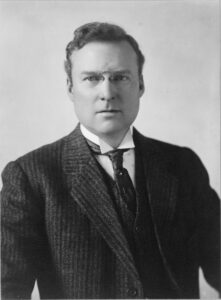
The case presented some puzzling questions for Judge Carpenter, a native Chicagoan who’d served as a Cook County judge for six years before becoming a federal judge in 1910, nominated by President William Howard Taft.13 Carpenter’s most famous case was the 1913 trial of Black heavyweight boxing champion Jack Johnson for allegedly violating the Mann Act, when he’d sentenced Johnson to one year and one day in prison.14
In the “Livery Stable Blues” case—Hart et al. v. Graham—Carpenter clearly had trouble grappling with the question of how to determine the song’s authorship, and not just because the witnesses told contradictory stories about its origins. It was also a struggle to figure out how that era’s copyright law applied to a song created by musicians who played by ear, devising songs without writing them down as old-fashioned sheet music.
“You see, nobody wrote ‘Livery Stable Blues,’” Nuñez testified. “Naw. Nobody writes any of that stuff.” When the clarinetist said this, he was using the word write in a very literal sense. It’s true that he did not take a pen or pencil and write those notes down on a sheet of paper. But that didn’t mean he hadn’t played a part in composing the music.15
Summarizing Nuñez’s testimony, the Daily News explained he was contending that “Livery Stable Blues” “was not the work of one creative brain, that it rather evolved out of the combined genius of the Original Dixie Jazz Band of which he was a member.”16
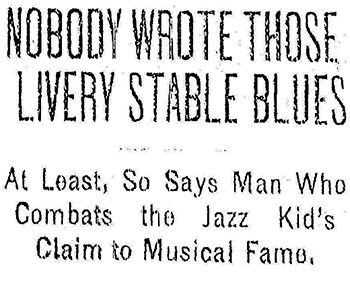
The trial’s witnesses included an African American musician, identified by the Chicago Herald as “Professor James Aristotle Slap White, critic and composer of many syncopated rags and jazzified ‘drags.’” 17 The Tribune called him “Prof. Beethoven (alias Slap) White, Negro jazz hound, composer of ‘Snakebite Blues’ and author of over four hundred other compositions.”
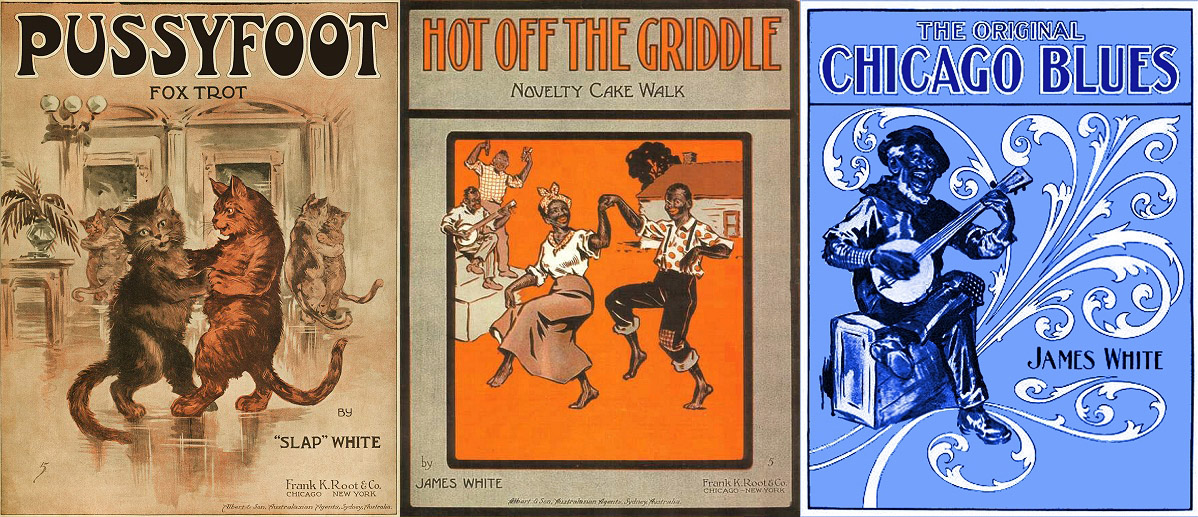
His actual name was James Madison White. Born in Coffeeville, Alabama, the 36-year-old been working as a piano player and songwriter in Chicago for about a decade. His published songs included “Pussyfoot,” “Hot Off the Griddle,” “Neutrality Rag” (whose title referred to the U.S. policy of staying out of World War I), and a 1915 song with a title that made a bold declaration for the tune’s place in musical history: “The Original Chicago Blues.” White worked in collaboration with Roger Graham, who called him “a colored Irving Berlin.” It’s uncertain how he got the “Slap” nickname.18
When he took the witness stand in 1917, “Prof. White gummed up the trial by stating that all blues were alike,” according to the Tribune. Here’s a sample of White’s testimony:
“What is melody?”
“Melody? Why—ha, ha!—melody’s jes’ plain melody.”
“Well, what are blues?”
“Blues are blues.”
“Are there no differences between the various blues?”
“Well, they might be, but, on the other hand, all blues are the same. Take ‘Alligator Blues’ and ‘Ostrich Walk Blues.’ They’re different, but they’re both blues, and all blues are blues.”19
Nuñez made a similar statement, testifying: “All blues is alike. They come from a sort of song that all the colored folks sings when they gets lonely.”20 Another report quoted Nuñez as saying: “Judge, blues is blues—a little off key but harmony against the rules.”21
Another witness was May Olivette Hill, whom the Daily News described as “one of the popular song boosters in the city and a composer herself of blues and jazzes.”22 The 29-year-old Cleveland native23 was Graham’s songwriting partner—she wrote melodies, and he wrote lyrics—as well as his office manager and fiancée.24
Hill testified that “Livery Stable Blues,” “More Power Blues,” and several other songs with the word “blues” in their titles were fundamentally alike.
“Could they all be played at once?” the judge asked.
“They could, and produce perfect harmony,” she answered.25
“Well, could the average layman tell these melodies apart if the band played them and jazzed them up right?” the judge asked.
“No, you’d know that they were playing, but you wouldn’t know what; even I couldn’t tell,” she said.
“That’s what I thought jazz was like,” the judge remarked.26

The Tribune reported: “Judge Carpenter, a bit of a musician himself, ordered a jazz band held in readiness to play … for the court.”27 But Carpenter never called on any musicians to perform the disputed compositions. And the surviving court documents don’t say if the judge played any records in the courtroom, either.28
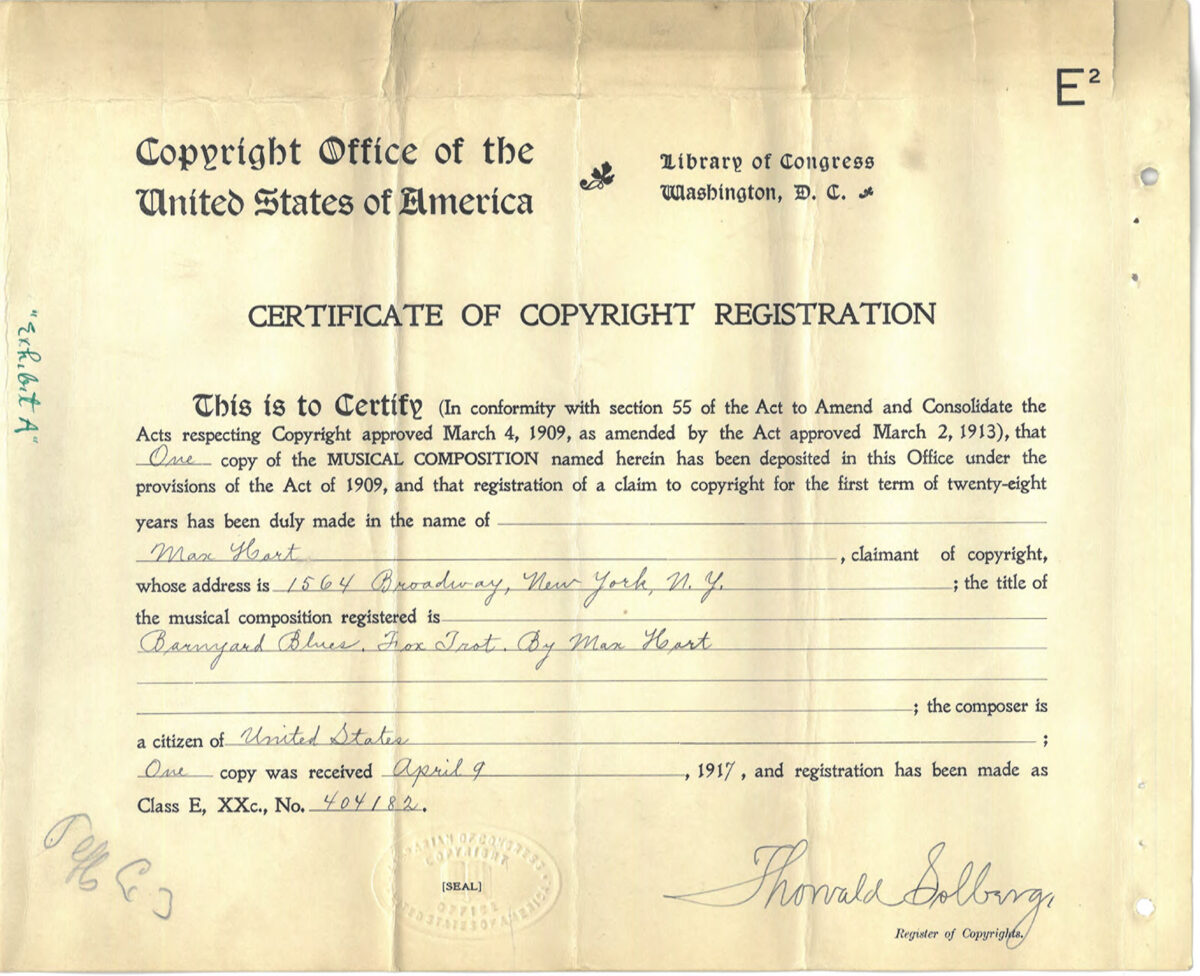
Unfortunately, no recording of “More Power Blues” exists, making it all but impossible for us to compare the songs today. And, more crucially for the copyright law at the time of this trial, no sheet music seems to exist for “More Power Blues.”

After hearing all of this testimony, Carpenter reached a confounding conclusion, speaking from the bench on October 12.
According to Carpenter, neither side was claiming credit for adding barnyard noises to the song. “The only claim appears to be for the melody,” he said. And yet, the judge believed that those “interpolated animal and bird calls” were the only thing of any value in “this so-called musical production.” Carpenter said this conclusion was “perfectly apparent from the evidence given by all the witnesses.” But in spite of that, he said, “The cat calls and animal calls were not claimed in the bill and they were not included in the copyright, so we are to exclude them in this question. The only question is: Has there been a conceived idea of the melody that runs through this so-called ‘Livery Stable Blues’?”
As for that tune, Carpenter said: “I am inclined to take the view of Professor Slap White in this case, that it is an old Negro melody, that it has been known for a great many years.” The judge sounded skeptical about the various contradictory stories he’d heard about who wrote the melody and when they wrote it. “But the court is satisfied, from having looked over the manuscripts, that there is a very decided resemblance between the aria—the melody of ‘More Power Blues’ and the ‘Livery Stable Blues,’” he said. Note how he started to call it an “aria,” using a word more typically applied to opera than to popular music, before correcting himself and saying “melody.”
“The finding of the Court is therefore that neither Mr. LaRocca and his associates nor Mr. Nuñez and his associates conceived the idea of this melody,” Carpenter said. “They were a strolling band of players and like—take the Hungarian orchestra—accomplished the result and not the original music itself.”
What exactly was the judge trying to say here? Which group of musicians was he talking about? He may have been referring to Brown’s Band, which did perform in the streets of New Orleans before coming to Chicago. Carpenter seemed to be suggesting that some “strolling” musicians improvising melodies couldn’t be considered true composers worthy of copyright protection. But how had they “accomplished the result and not the original music itself”? Did he mean that they’d hit upon some melody they’d previously heard elsewhere? (And what was he talking about when he interjected a mention of “the Hungarian orchestra”?)
The judge continued: “And I venture to say that no living human being could listen to that result on the phonograph and discover anything musical in it, although there is a wonderful rhythm, something which will carry you along especially if you are young and a dancer.”
So, as far as Carpenter was concerned, a record could have “a wonderful rhythm”—one that makes young people want to dance—even if the record doesn’t have “anything musical in it.” Rhythm, of course, is a key component of music.
The judge went on: “There are very interesting imitations, but from a musical standpoint it is even outclassed by our modern French dissonance.”
Imitations of what? Carpenter seemed to be saying that these players were just would-be musicians, trying to imitate what he considered real music. With this statement, the judge was revealing a bias toward traditional classical music. Did he believe the other types of music were less worthy of copyright protection? He apparently ranked “modern French dissonance”—referring, maybe, to composers such as Claude Debussy and Maurice Ravel—lower than other classical music. And the jazz music on this record was “even outclassed” by that dissonant French music.
Judge Carpenter now arrived at the final sentence of his ruling: “And the finding of the court will be that neither the plaintiff nor the defendant is entitled to a copyright, and the bill and the answer will both be dismissed for want of equity.”29
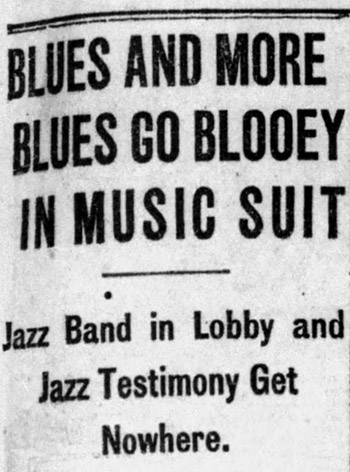
Carpenter seemed to be suggesting that this entire form of music—blues and jazz songs using chords and melodies similar to earlier songs—wasn’t entitled to any legal protection. As far as he could tell, blues songs were all the same. So how could they be protected by copyright?
In a 2012 master’s thesis about the case, Katherine Murphy Maskell explained that Carpenter had to follow the 1909 Copyright Act, which protected sheet music, not sound recordings. To register a musical work for copyright, you had to submit a written composition as the “deposit copy” to the U.S. Copyright Office. Maskell observed:
Many musical works do not reside in sheet music. Early jazz songs like “Livery Stable Blues” germinated from oral transmission, often before being notated in written sheet music. … As such, the song as a musical work was not dependent on written notation to exist or to be transmitted. In order to receive federal protection, these pieces would have had to comply with copyright statute. …
Although there was a rich precedent for copyright cases involving rights appropriation for original and derivative works, the lack of common law precedent regarding jazz and blues forced the court to formulate its decision based on its statutory understanding of “original works of authorship.”30
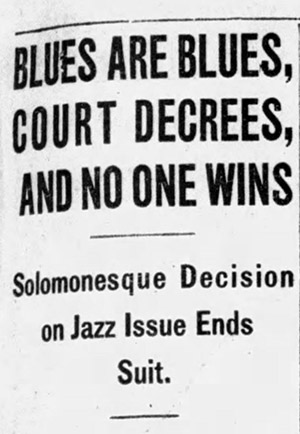
After Carpenter’s ruling, a Tribune headline declared: “Blues Are Blues, Court Decrees, and No One Wins. Solomonesque Decision on Jazz Issue Ends Suit.”
The same article offered this prediction: “The decision will affect a large number of azure syncopations. Since the latter part of 1915, when jazz bands, which had for some months been flourishing in New Orleans, left their native habitat and began to flourish in the metropoli of the nation, numberless blues have been inflicted upon the public.”31
However, it’s not clear how much impact Carpenter’s ruling actually had. While it may have seemed like a groundbreaking moment in legal and music history—a federal judge ruling on the authorship of the first jazz record and questioning whether any blues songs could be copyrighted—his dismissal was not widely published, beyond the pages of newspapers. “The decision is not included in the Federal Report, making it relatively inaccessible to lawyers and legal historians,” Maskell wrote.32
Copyright law has changed since the 1917 jazz trial. For one thing, the 1976 Copyright Act—which went into effect January 1, 1978—allowed sound recordings, and not just sheet music, to be used as deposit copies as a way of copyrighting pieces of music.

But the same issues Judge Carpenter examined in 1917 continue to loom large in recent litigation over music copyright, including the lawsuit that accused Ed Sheeran of copying Edward Townsend and Marvin Gaye’s “Let’s Get It On” when he wrote “Thinking Out Loud.” Sheeran won that case.
As reporter John Seabrook explained in a 2023 New Yorker story, the 1908 Copyright Act still applies to pre-1978 songs. So, the jury wasn’t allowed to listen to the Marvin Gaye record, instead looking at five pages of sheet music.
Sheeran’s legal team argued that the two songs shared a common chord progression and a common syncopated rhythm, neither of which can be copyrighted—similar to the notion expressed in the 1917 about all blues songs being alike. According to Sheeran’s lawyers, no one owns these “common musical elements.” Or as Seabrook put it: “Most pop songs are made out of other pop songs. Many are constructed on three- or four-chord progressions, and have a near-identical blueprint—intro, verse, chorus, bridge, outro. Other than words and melody, not much in a composition is protected by copyright.”
The same issues came up in other recent trials, including a verdict that decided Robin Thicke’s hit “Blurred Lines” was a copy of Marvin Gaye’s “Got to Give It Up.” Another verdict found that Led Zeppelin’s “Stairway to Heaven” did not infringe on Spirit’s “Taurus,” because the similarities between those two songs were “common musical elements” that can’t be copyrighted.
In his article exploring these cases, Seabrook wrote:
Almost all the major African American contributions to American music—ragtime, jazz, swing, hip-hop—were built on rhythmic innovations that weren’t transcribed in sheet music and copyrighted. (The bent third and seventh blue notes that lie at the heart of the blues can’t even be written in twelve-note chromatic-scale notation.) Ingrid Monson, the Quincy Jones Professor of African American Music at Harvard, who also served as an expert witness for the Gaye family in the “Blurred Lines” trial, told me, “There could be no copyright system less suited to rewarding the creativity of African American music than the one we have. It was obviously modelled on classical music, and on the idea that a real piece of music, one that was worthy of copyright, would be written in notation.” 33
More than a century after a federal judge in Chicago tried to figure out who wrote a jazz-blues song with horns imitating barnyard animals, courts are still struggling to define which parts of a song are common property belonging to everyone—fair game for anyone to copy—and which parts are protected by copyright.
<— PREVIOUS CHAPTER / TABLE OF CONTENTS / NEXT CHAPTER —>
Footnotes
1 Katherine Murphy Maskell, “Who Wrote Those ‘Livery Stable Blues’?: Authorship Rights in Jazz and Law as Evidenced in Hart et al. v. Graham,” master’s thesis, Ohio State University School of Music, 2012, https://etd.ohiolink.edu/apexprod/rws_etd/send_file/send?accession=osu1338343959&disposition=inline,1-2.
2 Advertisement, New Orleans Item, May 11, 1917.
3 Depositions of Alcide Nunez and Raymond E. Lopez, Hart et al. v. Graham (N.D. Ill. 1917), Case File E914; U.S. District Court for the Northern District of Illinois, Eastern Division (Chicago); Records of District Courts of the United States, Record Group 21; National Archives and Records Administration Great Lakes Region (Chicago); transcription in Maskell, “Who Wrote Those ‘Livery Stable Blues’?,” 129-130, 236-237.
4 “Nobody Wrote Those Livery Stable Blues,” Chicago Daily News, October 12, 1917, 3.
5 Ray Lopez and Alcide Nunez (music) and Marvin Lee (words), “Livery Stable Blues” (Chicago: Roger Graham, 1917), David M. Rubenstein Rare Book & Manuscript Library, Duke University, https://idn.duke.edu/ark:/87924/r49z94k7k.
6 Katherine Maskell Leo, “Hart v. Graham (N.D. Ill. 1917) (Case File E914),” GW Law Blogs, accessed July 4, 2023, https://blogs.law.gwu.edu/mcir/case/hart-v-graham/; “Dixieland Jass Band One-Step,” Wikipedia, accessed July 5, 2023, https://en.wikipedia.org/wiki/Dixieland_Jass_Band_One-Step.
7 Maskell, “Who Wrote Those ‘Livery Stable Blues’?” 1.
8 Maskell, “Who Wrote Those ‘Livery Stable Blues’?” 27.
9 Maskell, “Who Wrote Those ‘Livery Stable Blues’?” 5-6, 27.
10 “Nick LaRocca,” Wikipedia, accessed August 13, 2023, https://en.wikipedia.org/wiki/Nick_LaRocca.
11 “Discoverer of Jazz Elucidates in Court,” Chicago Daily News, October 10, 1917, home edition, 1.
12 “At Last! Court Finds Man Who First Jazzed,” Chicago American, October 11, 1917, 1. Transcription: Hart v. Graham, Maskell transcription, 283-284.
13 “George Albert Carpenter,” Wikipedia, accessed August 13, 2023, https://en.wikipedia.org/wiki/George_Albert_Carpenter.
14 “Jack Johnson’s Arrest,” PBS, accessed August 13, 2023, https://www.pbs.org/kenburns/unforgivable-blackness/johnsons-arrest.
15 “Nobody Wrote Those Livery Stable Blues.”
16 “Discoverer of Jazz Elucidates in Court.”
17 “All Know Jazz, But No Music,” Chicago Herald, October 12, 1917, 3, transcription in Maskell, “Who Wrote Those ‘Livery Stable Blues’?” 289.
18 Bill Edwards, “James Madison ‘Slap’ White,” RagPiano.com, accessed August 12, 2023, http://www.perfessorbill.com/comps/jwhite.shtml.
19 “Blues and More Blues Go Blooey in Music Suit,” Chicago Daily Tribune, October 12, 1917, 11.
20 “Nobody Wrote Those Livery Stable Blues.”
21 Walter Kingsley, “Vaudeville Volleys,” Dramatic Mirror, December 14, 1918, 867, transcription in Maskell, “Who Wrote Those ‘Livery Stable Blues’?” 294.
22 “Nobody Wrote Those Livery Stable Blues.”
23 Ohio, U.S., Births and Christenings Index, 1774-1973, Ancestry.com.
24 “Roger A. Graham,” Wikipedia, accessed August 13, 2023, https://en.wikipedia.org/wiki/Roger_A._Graham; “May Hill Making Good,” New York Clipper, November 7, 1914, 4, https://idnc.library.illinois.edu/cgi-bin/illinois?a=d&d=NYC19141107.1.4&e=07-11-1914-07-11-1914–en-20-NYC-1–img-txIN-%22May+Hill%22——-American+Popular+Entertainment–; “Love Note,” New York Clipper, September 26, 1914, 7, https://idnc.library.illinois.edu/cgi-bin/illinois?a=d&d=NYC19140926.2.222&srpos=1&e=26-09-1914-26-09-1914–en-20-NYC-1–img-txIN-%22May+Hill%22——-American+Popular+Entertainment–.
25 “Nobody Wrote Those Livery Stable Blues.”
26 “Jazz Band May Play in Court,” Chicago American, October 12, 1917, 10th edition, sports section, 1, transcription in Maskell, “Who Wrote Those ‘Livery Stable Blues’?” 287.
27 “Blues and More Blues Go Blooey in Music Suit,” Chicago Daily Tribune, October 12, 1917, 11.
28 Maskell, “Who Wrote Those ‘Livery Stable Blues’?” 82.
29 Court Findings, Hart et al. v. Graham, transcription in Maskell, “Who Wrote Those ‘Livery Stable Blues’?” 276-277.
30 Maskell, “Who Wrote Those ‘Livery Stable Blues’?” 71, 83, 86.
31 “Blues Are Blues, Court Decrees, and No One Wins,” Chicago Daily Tribune, October 13, 1917, 13.
32 Maskell, “Who Wrote Those ‘Livery Stable Blues’?” 89.
33 John Seabrook, “The Case for and Against Ed Sheeran,” New Yorker, June 5, 2023, https://www.newyorker.com/magazine/2023/06/05/ed-sheeran-copyright-infringement-lawsuit-marvin-gaye.
